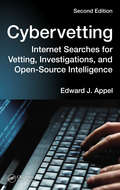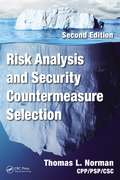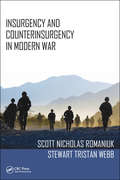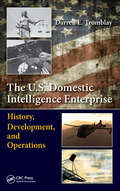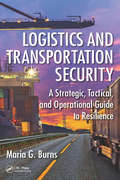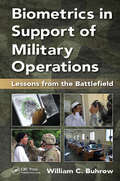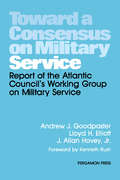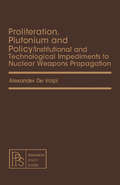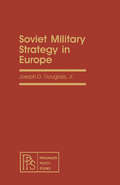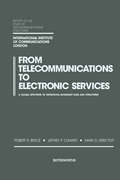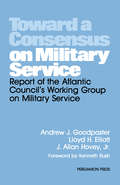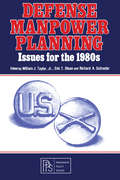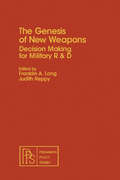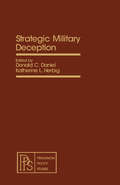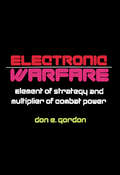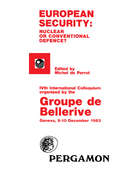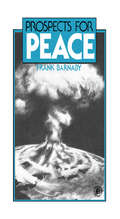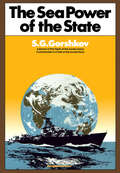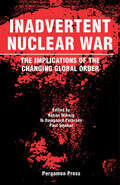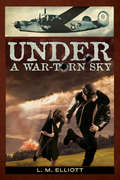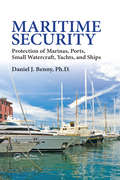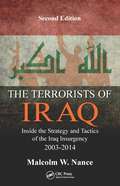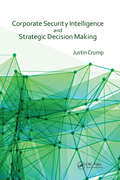- Table View
- List View
Cybervetting: Internet Searches for Vetting, Investigations, and Open-Source Intelligence, Second Edition
by Edward J. AppelResearching an individual‘s, firm‘s or brands online presence has become standard practice for many employers, investigators, and intelligence officers, including law enforcement. Countless companies and organizations are implementing their own policies, procedures, and practices for Internet investigations, cybervetting, and intelligence.
Risk Analysis and Security Countermeasure Selection
by Thomas L. Norman CPP/PSP/CSCThis new edition of Risk Analysis and Security Countermeasure Selection presents updated case studies and introduces existing and new methodologies and technologies for addressing existing and future threats. It covers risk analysis methodologies approved by the U.S. Department of Homeland Security and shows how to apply them to other organizations
Insurgency and Counterinsurgency in Modern War
by Scott Nicholas Romaniuk Stewart Tristan WebbA collection of original works covering all aspects of insurgency and counterinsurgency through a multinational lens, Insurgency and Counterinsurgency in Modern War addresses the need to look beyond the United States and other prominent counterinsurgency actors in the contemporary world. It also reassesses some of the latent and burgeoning insurgen
The U.S. Domestic Intelligence Enterprise: History, Development, and Operations
by Darren E. TromblayMuch has been written about U.S. intelligence operations. However, intelligence, as it is conducted in the U.S. domestic environment, has usually been treated in a fractured and sensationalistic manner. This book dispassionately assesses the U.S. domestically oriented intelligence enterprise by first examining its individual components and then sho
Logistics and Transportation Security: A Strategic, Tactical, and Operational Guide to Resilience
by Maria G. Burns"Professor Burns has captured the essence of transportation security, one of today's most pressing concerns. As the rate of globalization and world trade increases, security and supply chain resilience are at the core of one�s global transportation network. This is a timely and well written contribution to the industry."�John A. Moseley, Senior Dir
Biometrics in Support of Military Operations: Lessons from the Battlefield
by William C. BuhrowBiometrics in Support of Military Operations: Lessons from the Battlefield examines and evaluates recent U.S. military experiences in Iraq and Afghanistan in the context of the use of biometrics and related technologies. The book takes a comprehensive look at how biometrics has been used to support various military operations and suggests ways that its uses can be further developed. It fills a void in understanding how to incorporate biometrics by providing a guide to develop and establish formal operational roles and procedures when applying the technology. Written in an informal style that makes it accessible to people who are not necessarily operators or technicians of biometrics technologies, this book bridges an existing gap to better educate leaders inside and outside of the U.S. military on the far-reaching potential of biometrics in support of tactical operations. It argues that the gap between those inside and outside the military is the result of failure to document lessons learned from battle experience, as well as a lack of a combined vision among the Joint Forces to fully recognize and exploit the capabilities of biometrics for enhanced future success. This book fills that gap. Biometrics has great potential as an effective tool if properly developed and utilized. The book concludes with a look at the future of emerging applications for the military but also considers a wider range of deployment of biometrics outside the military, such as in governmental organizations, including foreign diplomacy. Biometrics can be applied to any operational area that requires accurate and rapid identification of unknown individuals in order to support its operations and protect personnel and resources. Biometrics in Support of Military Operations is an important beginning point in an emerging field for gaining understanding and better mastery of biometrics.
Toward a Consensus on Military Service: Report of the Atlantic Council's Working Group on Military Service
by Andrew J. Goodpaster Lloyd H. Elliott J. Allan HoveyToward a Consensus on Military Service: Report of the Atlantic Council's Working Group on Military Service compiles the work of several authors who are all members of Working Group on Military service. Each chapter tackles relevant issues regarding the U.S. peacetime military volunteer force, such as its previous experiences and future prospects. The opening chapter covers the setting, which in turn provides a geopolitical overview of the issues faced by the U.S. military. The next chapter discusses the history of American military recruitment system, from colonial times up to the last draft era. Chapter 3 tackles the present and future of the U.S. security requirements, while the next chapter discusses the concept of an all-volunteer force as well as its implications. The fifth chapter provides an analysis of the experience and prospects of military reserves in the all-volunteer era. Chapter 6 discusses the possible repercussions of an all-volunteer forces as well as the possible remedy of such predicament. Chapter 7 explains several recruitment options for both active and reserve forces, while the Chapter 8 discusses the use of a compulsory military service when an all-volunteer system is proven inadequate. The ninth chapter examines the relationship between how the U.S. military builds up its military manpower and how it affects U.S. society both morally and ethically. The last chapter provides recommendation based on the information inferred from the previous chapter.
Great Power Competition for Overseas Bases: The Geopolitics of Access Diplomacy
by Robert E. HarkavyGreat Power Competition for Overseas Bases: The Geopolitics of Access Diplomacy explores the geopolitics of the major powers' overseas basing systems in relation to global strategies and changes in the international system in three fairly distinct phases: the interwar, early postwar, and recent postwar periods. This book links the great powers' competition for overseas bases to several streams of more or less contemporary international relations theory. This monograph consists of seven chapters and opens with an introduction to the diplomacy of basing access, followed by a discussion on the different types or purposes of basing access as they have evolved over the past several decades in response to changes in diplomacy and military technology. The major powers' overseas basing-access networks in the consecutive interwar, early postwar, and recent postwar periods are then reviewed, along with the earlier corpus of geopolitical theory, specifically as it relates to basing diplomacy. Emphasis is on the conflicting assumptions about what reciprocal strategic advantages and disadvantages inhere to the geographic positions of the United States and USSR. The final chapter considers a number of ""functional"" areas of world politics that are closely intertwined with basing diplomacy, and relates the competition for facilities to raw materials access, surrogate wars, strategic deterrence, arms control, balances of payments, arms sales and aid, alliances, and other such staple concerns of international relations. This book will be of interest to political scientists, military and government officials, diplomats, and policymakers.
Why ABM: Policy Issues in the Missile Defense Controversy
by Johan J. Holst William SchneiderWhy ABM?: Policy Issues in the Missile Defense Controversy focuses on the problems of invention and deployment of defenses against anti-ballistic missiles (ABM). The book first discusses early, present, and future missile defense systems, including the efficiency of missile defense and the use of missiles in penetration aids and tactics. The deployment of ballistic missile defense (BMD) is explained. The text takes a look at the missile defense systems of the Soviet Union and their participation in the arms race. The reactions of the Soviet Union on the use of BMD and positions of Soviets and Americans on arms race issues are underscored. The selection reviews the implications of missile defense on Europe. Concerns include arms control and the prospects of European settlement; impact on the future of NATO; and attitude toward China. The possible effects of ABM on non-proliferation are also discussed. The text also takes a look at strategic arms control and stability. This topic includes effects on diplomatic relationships and debates on the use and deployment of missiles in defense strategies. The book is a vital source of reference for readers interested in international security, particularly the use of missiles in defense systems.
Proliferation, Plutonium and Policy: Institutional and Technological Impediments to Nuclear Weapons Propagation
by Alexander De VolpiProliferation, Plutonium and Policy/Institutional and Technological Impediments to Nuclear Weapons Propagation provides a comprehensive account of the political and technological aspects of nuclear weapons proliferation. The technical feasibility of denaturing plutonium is addressed and the extent of the weapons proliferation problem is analyzed. Strategies for minimizing nuclear weapons propagation are recommended. This book is comprised of four chapters and opens with an overview of nuclear fission and the problem of nuclear weapons proliferation, paying particular attention to the importance of international agreements and safeguards in achieving a meaningful (but non-zero) level of restraint on nuclear weapons proliferation. The next chapter considers the use of denatured plutonium and other fission reactor byproducts as a technological option for mitigating proliferation problems. The impact of denatured plutonium on the global operation of nuclear reactors is also discussed. The final chapter assesses the major implications of all proliferation problems within the framework of a sound antiproliferation strategy. This monograph will be of interest to political scientists, policymakers, diplomats, and government officials.
Soviet Military Strategy in Europe: An Institute for Foreign Policy Analysis Book
by Joseph D. DouglassSoviet Military Strategy in Europe focuses on the development, form and content, implications for international relations, and goal of Soviet military plan in Europe. The book first discusses the foundation of Soviet military thought and revolution in Soviet military affairs, including basic concepts of the Marxist-Leninist ideology, Soviet study of military affairs, nuclear revolution, and scientific and technical revolution. The publication also concentrates on Soviet study of laws and principles of military art and forces and primary operational concepts. Topics include laws of the first order, naval and air operations, nuclear strike, and conventional war considerations. The manuscript ponders on command and control, as well as combat modeling, survivability, coordination, centralization, and attack of NATO command and control. The book also reviews the issues of Soviet military strategy toward Europe and special Soviet problems. Topics include role of nuclear weapons, chemical warfare options, escalation to intercontinental war, NATO nuclear threat, nuclear weapon stockpile, and superiority and war initiation. The publication is a dependable reference for readers interested in the Soviet military scheme in Europe.
From Telecommunications to Electronic Services: A Global Spectrum of Definitions, Boundary Lines, and Structures
by Robert R. Bruce Jeffrey P. Cunard Mark D. DirectorReport of the Study of Telecommunications Structures: From Telecommunications to Electronic Services: A Global Spectrum of Definitions, Boundary Lines, and Structures focuses on the advancements in the processes, methodologies, and regulations involved in telecommunications and electronic services. The book first elaborates on common themes and a comparative analysis, including a comparative assessment of definitional and boundary line issues; varying national approaches to the structures of the telecommunications industry; and "engines" for change, institutional mechanisms, and economic pressures. The manuscript then examines international policy issues and institutional perspective of international issues. Topics cover agreements for information and financial service-oriented networks; enhanced service interconnection; impact of international satellite services on national tariff and service policies; and spillover of changes in domestic policy to the international arena.The publication takes a look at the growth of telecommunications and electronic services in the United States, United Kingdom, Japan, and Canada. Discussions focus on the British approach to service definitions and categories; definitional issues raised by the telecommunications business law; reconciling competitive goals with advanced service capabilities; jurisdictional boundaries in Canadian telecommunications; and domestic satellite policies.The text is a valuable source of data for telecommunications and electronic services experts wanting to explore the progress in telecommunications and electronic services.
Toward a Consensus on Military Service: Report of the Atlantic Council's Working Group on Military Service
by Andrew J. Goodpaster Lloyd H. ElliottToward a Consensus on Military Service: Report of the Atlantic Council's Working Group on Military Service examines the experience and prospects of the U.S. peacetime military volunteer force. It presents a Policy Paper that offers a broad range of recommendations designed both to strengthen that force and to prepare the way, should circumstances require it, for a resumption of compulsory military service. The book begins by providing a geopolitical backdrop for the issues of U.S. military service examined in subsequent chapters. It analyzes basic U.S. national interests, Soviet power and policy, and East-West relations. This is followed by separate chapters on the antecedents of force-manning in the U.S.; current and evolving concepts of U.S. security requirements; the all-volunteer force; and military manpower policies. Subsequent chapters examine long-term military manpower trends and criteria for a peacetime military force; compulsory service options; and social and ethical issues that have colored the historical American debate over how the nation should raise its armed forces in peacetime.
Defense Manpower Planning: Issues for the 1980s
by William J. Taylor Eric T. Olson Richard A. SchraderDefense Manpower Planning discusses the important set of national security issues related to defense manpower for the 1980s. The topics in the text focus on the problems of manpower acquisition and retention. The historical background and description of the military power during the 1970s and 1980s are given in detail. A military manpower chronology is provided. The book enumerates some of the manpower issues and debates. Such salient issues as the quantity, quality, socio-economic factors, and the issue of cost, combat effectiveness, and readiness factors are carefully considered. After listing the issues, solutions are then presented. The variants of the all-volunteer force, of conscription, and combining volunteers and conscripts are suggested. A part of the book focuses on active duty forces. The issue of employing women in the military is fully addressed. A description of combat is also tackled. A section of the text explains the relationship between precision guided munitions and the volunteer force. The book will provide useful information to defense military planners, historians, and students of history.
The Genesis of New Weapons: Decision Making for Military R & D
by Franklin A. Long Judith ReppyThe Genesis of New Weapons: Decision Making for Military R&D covers the meeting held to convene military officers, civilian managers of R&D programs, and members of the research groups in industry and get insights from them regarding the decision-making process for initiation and carrying out of R&D programs. The book first gives an introductory overview of the decision making in the military R&D. Topics on the problems usually encountered are then examined. These problems include bureaucratic and other problems in planning and managing military, decision making, and defense. Then, the text discusses the birth of weapons and the R&D process. Finally, the book looks into the political intervention and its implications for the military R&D. The selection will be beneficial to those in the military, government offices, and related agencies or sectors.
Strategic Military Deception: Pergamon Policy Studies on Security Affairs
by Donald C. Daniel Katherine L. HerbigStrategic Military Deception explains the nature of deception, its processes, and the elements and conditions when a person used and succeeds at deception. The main focus of the book is the discussion of strategic military deceptions. The book is mainly a collection of research that seeks to develop a common idea of deception’s basic elements and its relationships. The first part of the book contains such topics as the application of game, communication, organization, and systems theories. The second part of the book deals with the testing and validation of some of the theories of deception through a series of historical case studies. By analyzing a series of cases, the book identifies some recurring patterns in a group of deception cases. There are also chapters that focus on the use of deception during World War II. The book will be a useful tool for military agents, game theorists, and psychoanalysts.
Electronic Warfare: Element of Strategy and Multiplier of Combat Power
by Don E. GordonElectronic Warfare: Element of Strategy and Multiplier of Combat Power describes how the application of electronic warfare allowed the Allies to multiply combat power during World War II in order to accomplish strategic objectives. This book is composed of eight chapters that also consider how the United States had best prepare a strategy to fight on the battlefield with electronic warfare. After briefly presenting the history of electric warfare equipment, this book goes on exploring the technologies of cryptology and microwave radar, and their significance in the battle. These topics are followed by a chapter focusing on the accomplishments of the German surface fleet. The succeeding chapters demonstrate the power of German army with their U-boats, and cruisers, Scheer, Lutzow, Hipper, and Prinz Eugen. The final chapter looks into the issues of preparedness, the cost of defense, the role of technology, political and economic appraisal, and the need to multiply combat power quickly and inexpensively.
European Security: Nuclear or Conventional Defence?
by Michel De PerrotEuropean Security: Nuclear or Conventional Defence? documents the proceedings of the IVth International Symposium held in Geneva on December 8-10, 1983. This book compiles papers on the INF negotiations on intermediate-range nuclear missiles in Europe and START talks on strategic nuclear arms, focusing on four themes— nuclear threats, public reactions, arms race and arms control, and alternative paths. The topics discussed include consequences in Europe of a nuclear conflict; expected impact of the use of nuclear weapons on battlefields, towns, and cities; peace movements in Europe; and Europe and non-violent defense. The aims, roles and prospects of arms control; problem of conventional defense; risk of nuclear war; and nuclear disarmament are also deliberated in this text. This publication is a good source for students and researchers aiming to acquire knowledge of the possible consequences of a nuclear conflict in Europe.
Prospects for Peace
by Frank BarnabyProspects for Peace is an eight-chapter text that focuses on the issues and controversies in the so-called global peace.The first chapters provide a framework of the issues of global peace, the increasing probability of nuclear war, global militarization, and the spread and use of nuclear weapons. These topics are followed by discussions of legal policies concerning nuclear weapon, particularly nuclear war fighting weapon in Europe. A chapter examines the unimaginable consequences of nuclear war. The last chapter emphasizes the prospects for peace, including nuclear weapon disarmament and the control of military science.
The Sea Power of the State
by S.G. GorshkovAdmiral Gorshkov has transformed the Soviet fleet into a world sea power for the first time in Russian history. He is Russia's most brilliant naval strategist of all time. He has created the modern Soviet navy. His book examines the main components of sea power among which attention is focused on the naval fleet of the present day, capable of conducting operations and solving strategic tasks in different regions of the world's oceans, together with other branches of the armed forces and independently
Inadvertent Nuclear War: The Implications of the Changing Global Order
by Hå. Wiberg I. D. Petersen P. SmokerSince the dramatic end of the Pacific War in 1945 the threat of nuclear war has exercised the minds of many. Initial fears concerned the risk that a political crisis between the Superpowers would escalate through miltary confrontation into a 'calculated' nuclear war. Another scenario pictured a new Hitler commanding a nuclear-capable state prepared to use such weapons 'irrationally', possibly sparking a 'catalytic' nuclear war between the major Powers. More recently attention has shifted towards the risk of the 'accidental' release of nuclear weapons. While the risk of intentional conflict between the major Powers has lessened, the arsenals have only been marginally reduced, leaving the possibility of accidental release as perhaps the most threatening case. Inadvertent Nuclear War presents the risk in terms of the reliability and instability of the human and technical systems governing release, with contributions ranging from the engineering of computer software to the psychology of the chain of command. As Dr Wiberg states in his introduction, "No known technical construction, human being or social organization is absolutely failsafe."
Under a War-Torn Sky
by L.M. ElliottWounded and alone behind enemy lines, a young pilot must find his way to freedom in this gripping, beloved novel When Henry Forester is shot down during a bombing run over France, the World War II pilot finds himself trapped behind enemy lines. In constant danger of discovery by German soldiers, Henry begins a remarkable journey to freedom. Relying on the kindness of strangers, Henry moves from town to town--traveling by moonlight, never asking questions, or even the names of the people who help him along the way. Each day brings him closer to home, yet every step in enemy territory invites new dangers.Even as Henry fights for his own life, he quickly grows to realize the peril that surrounds all of the French people, and to admire the courage of the freedom fighters who risk death to protect him. Suspenseful and achingly true, this critically-acclaimed and deeply beloved novel explores the heartbreak of war, the strength of human spirit, and one young man's struggle to protect the things he loves.
Maritime Security: Protection of Marinas, Ports, Small Watercraft, Yachts, and Ships
by Ph.D, Daniel BennyIn a time when threats against the maritime community have never been greater, Maritime Security: Protection of Marinas, Ports, Small Watercraft, Yachts, and Ships provides a single, comprehensive source of necessary information for understanding and preventing or reducing threats to the maritime community.The book defines what comprises the mariti
The Terrorists of Iraq: Inside the Strategy and Tactics of the Iraq Insurgency 2003-2014, Second Edition
by Malcolm W. NanceThe Terrorists of Iraq: Inside the Strategy and Tactics of the Iraq Insurgency 2003-2014, Second Edition is a highly detailed and exhaustive history and analysis of terror groups that both formed the Iraq insurgency and led to the rise of the Islamic State of Iraq and Syria (ISIS). It places heavy emphasis on the history, organization, and personal
Corporate Security Intelligence and Strategic Decision Making
by Justin CrumpDespite a clear and compelling need for an intelligence-led approach to security, operational, and reputational risks, the subject of corporate security intelligence remains poorly understood. An effective intelligence process can directly support and positively impact operational activity and associated decision-making and can even be used to driv
